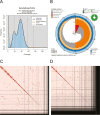Reference genome of the black rail, Laterallus jamaicensis
- PMID: 37119047
- PMCID: PMC10287143
- DOI: 10.1093/jhered/esad025
Reference genome of the black rail, Laterallus jamaicensis
Erratum in
-
Correction to: Reference genome of the black rail.J Hered. 2023 Aug 23;114(5):585. doi: 10.1093/jhered/esad038. J Hered. 2023. PMID: 37354561 Free PMC article. No abstract available.
Abstract
The black rail, Laterallus jamaicensis, is one of the most secretive and poorly understood birds in the Americas. Two of its five subspecies breed in North America: the Eastern black rail (L. j. jamaicensis), found primarily in the southern and mid-Atlantic states, and the California black rail (L. j. coturniculus), inhabiting California and Arizona, are recognized across the highly disjunct distribution. Population declines, due primarily to wetland loss and degradation, have resulted in conservation status listings for both subspecies. To help advance understanding of the phylogeography, biology, and ecology of this elusive species, we report the first reference genome assembly for the black rail, produced as part of the California Conservation Genomics Project (CCGP). We produced a de novo genome assembly using Pacific Biosciences HiFi long reads and Hi-C chromatin-proximity sequencing technology with an estimated sequencing error rate of 0.182%. The assembly consists of 964 scaffolds spanning 1.39 Gb, with a contig N50 of 7.4 Mb, scaffold N50 of 21.4 Mb, largest contig of 44.8 Mb, and largest scaffold of 101.2 Mb. The assembly has a high BUSCO completeness score of 96.8% and represents the first genome assembly available for the genus Laterallus. This genome assembly can help resolve questions about the complex evolutionary history of rails, assess black rail vagility and population connectivity, estimate effective population sizes, and evaluate the potential of rails for adaptive evolution in the face of growing threats from climate change, habitat loss and fragmentation, and disease.
Keywords: CCGP; California Conservation Genomics Project; Gruiformes; Rallidae; conservation genetics.
© The American Genetic Association. 2023.
Figures



